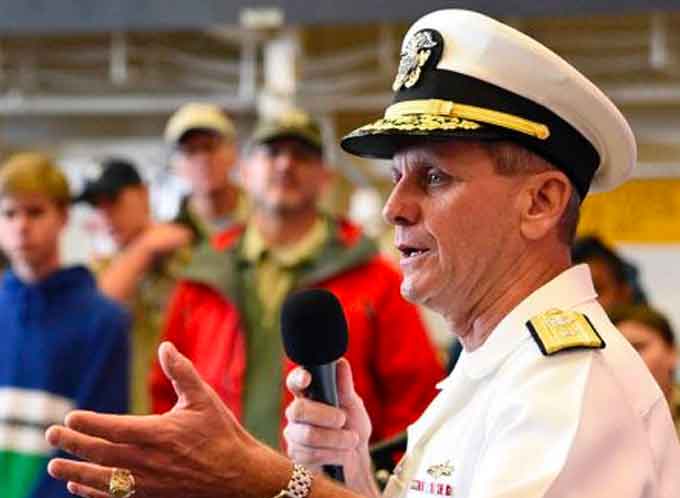
Commander, Naval Surface Force (CNSF) and Surface Warfare Officer Schools (SWOS) Command continue to conduct officer of the deck (OOD) competency checks across fleet concentration areas.
Conducted by SWOS, the competency checkpoints provide Vice Adm. Rich Brown, CNSF, data on how first-tour, qualified OODs perform in navigation, seamanship, and ship-handling, via written test and simulated at-sea scenarios.

The checks began in San Diego and have been conducted in Norfolk, Virginia and Yokosuka, Japan. They are occurring this week in Sasebo, Japan.
“This is an opportunity to take a running fix to make sure that the training we are providing our junior Officers is the right training, and if it isn’t, we will look to make adjustments,” said Brown.
The competency checks help SWOS assess the proficiency levels of the junior OODs and provide critical information on how they handle stressful situations.
The data gathered will help identify areas where SWOS can improve training.
These assessments are conducted on qualified OODs who are randomly selected from various ships in the fleet concentration area where the checks are taking place.
(The Officer of the Deck (OOD) competency checks are one of several initiatives designed by CNSF to improve the proficiency of Surface Warfare Officers and address issues identified in the ‘Comprehensive Review (CR) of Recent Surface Force Incidents in 2017. Courtesy of the U.S. Navy and YouTube. Posted on Feb 28, 2018)
They take an examination which includes questions from navigation rules of the road and applicable navigation and seamanship concepts, and then their ability to handle at-sea scenarios is evaluated in navigation, seamanship and ship-handling trainers (NSSTs).
These state-of-the-art bridge simulators are used to train ship crews in navigation and ship handling using virtual reality technology.
“Our main focus is to gather data to inform how we can better train future Surface Warfare Officers,” said Capt. Scott Robertson, commanding officer of SWOS.
“These competency checkpoints are designed to see how we are doing and where training gaps may lie in our officers of the deck.”

“By conducting the checks across all ship platforms and from different commissioning sources, the data will help us understand the proficiency level of our OODs.”
The intent of the competency checkpoints is not to take punitive action against these officers, but rather to build an understanding in what skill sets OODs are proficient and which skillsets they are deficient.
Leadership wants to ensure each OOD has the foundational training and relevant skills to safely navigate the world’s waters, and this is one of the many steps underway in the Surface Force.
“I do not believe anything like this has been done in the Surface Warfare Community before,” said Robertson.

“The time is right to really see what the trends are and then more importantly, take action to shore up holes.”
The OOD competency checks are one of several initiatives designed by CNSF to improve the proficiency of Surface Warfare Officers and address issues identified in the ‘Comprehensive Review (CR) of Recent Surface Force Incidents in 2017.’
The initiatives were established from feedback received during all-hands calls and leadership meetings following the mishaps.
The competency checks are meant to provide SWOS and the fleet an objective assessment of the Surface Forces junior OOD’s strengths and weaknesses.
Additionally, the information gathered will help entities in the training community tailor instruction and scenarios to address gaps that may exist.
Other initiatives include: increased shiphandling simulator training during the Basic and Advanced Division Officer Courses, mariner assessments during the Prospective Commanding Officer Course, a Junior Officer of the Deck Course, Bridge Resource Management Workshop, and additional OOD classroom and simulator training.

“The success of the Surface Force is measured by properly manned, tactically trained, and effectively equipped ships ready to provide Fleet Commanders with combat naval power to fight and win at sea and to project that power ashore,” said Brown.
“This is one step in assessing the professional growth of our officers and one step in ensuring our ships have the manning, training and equipment necessary to support our Fleet Commanders.”
In conjunction with the Readiness and Restoration Oversight Council (led by the Undersecretary of the Navy, Mr. Thomas Modly and the Vice Chief of Naval Operations, Adm. Bill Moran), and complimenting the CR recommendations, CNSF is focused on using these initiatives to improve Surface Forces at the unit and individual levels.
 These initiatives will help to improve the safety and readiness of Surface Navy’s ships.
These initiatives will help to improve the safety and readiness of Surface Navy’s ships.
Future SWOS-led competency checkpoints are planned in the fleet concentration areas of Mayport, Everett, Pearl Harbor and Rota.
















